Lost Gods
-
-
Defined in a cycle of mystery by the principle of ‘all is one’, existence itself unfolds on the canvas of the robust painting called ‘The Prophecy’. It projects the perfectly balanced symmetric arrangement of above and below, and the comprehensible reality of the Delphi shrine complex, also called ‘The Navel of the World’; together with the depths under the horizon that’s invisible to the earthly mortals. The mythical spaces interlocked by golden rays with sparkling light and the strong, granitelike fundaments portrayed as massive gold bars grants the ability of vision to the oracle, that is, to the motif depicting an enormous eye. Within the piercing glance the power of prediction exceeding time and dimensions manifests. The magnificent golden crown of glare is compartmentalized by the many showrooms containing sacrificial gifts. The surfaces shining in blue as representation of purity ensure the free confluence of superconscious forces. The color drops on the iris symbolise the forthcoming. The eternal flame guarded in the Temple of Apollo, positioned in the top left, is gradually overcast by black and red shadows. The sweetwater fountain of St. Castalia turns bitter and the prophecies previously born from divine interpretation become false guidance serving interests of power: the golden rays delivering the truth start fading. The clear sight of the famous shrine obscures, the magnificent iris crown becomes a bloody theater of blind visions. The destruction of the oracle is caused - besides a cluster of natural disasters - by a wrongful advice regarding the Persian war.
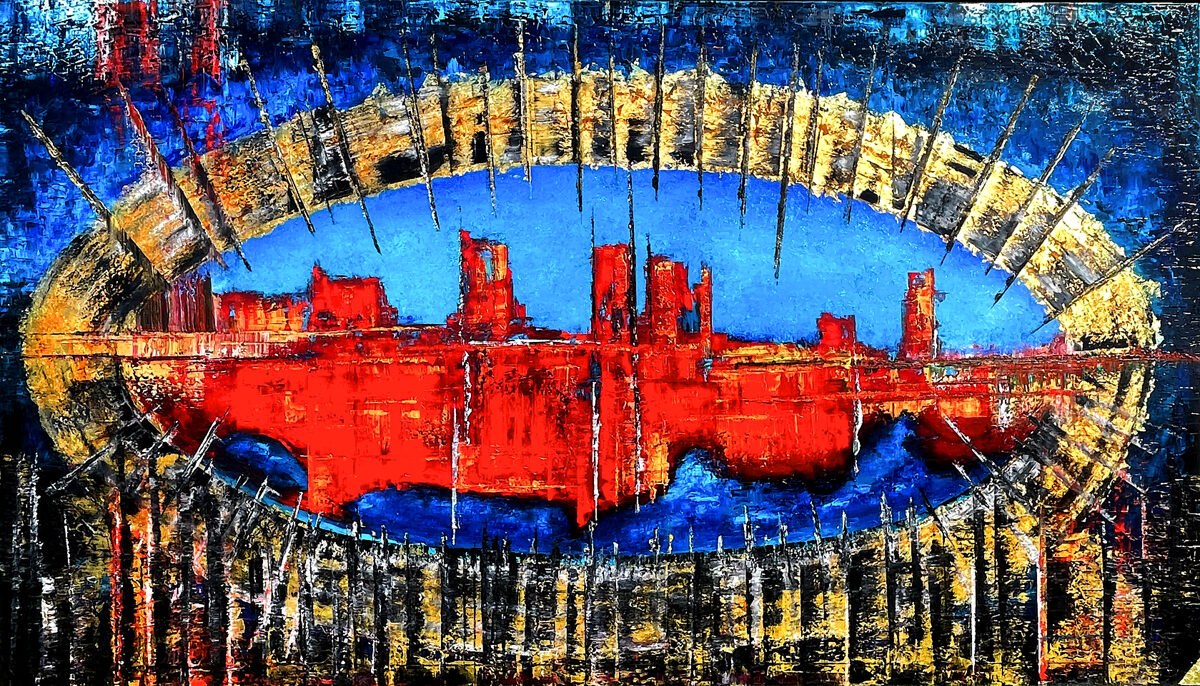
The division of the abstraction signals levels of consciousness according to the arrangement of world orders; at the upper range of the frame earthly existence unfolds with its dominant, vivid shapes and fruitios colors. At the turbulent lower part however, it’s the realm of pitch black shades, where departed souls mourn their once evident spark in desperate wandering. Outspread between, a glowing blue wave of mirror texture shows how the underworld is an upside down reflection of the World. The long, vertical strokes frozen in darkness, striking through the composition, represent the river Acheron, their unornamented vectors directed at the abyss biting into the flesh of time like a starving vulture. The bittered patches at the bottom right corner constitute an eye; Kharon, the ferryman of Hades, views the site with a sparkless glance: he is the one who carries souls of the newly deceased in his boat to the depths of the underworld.
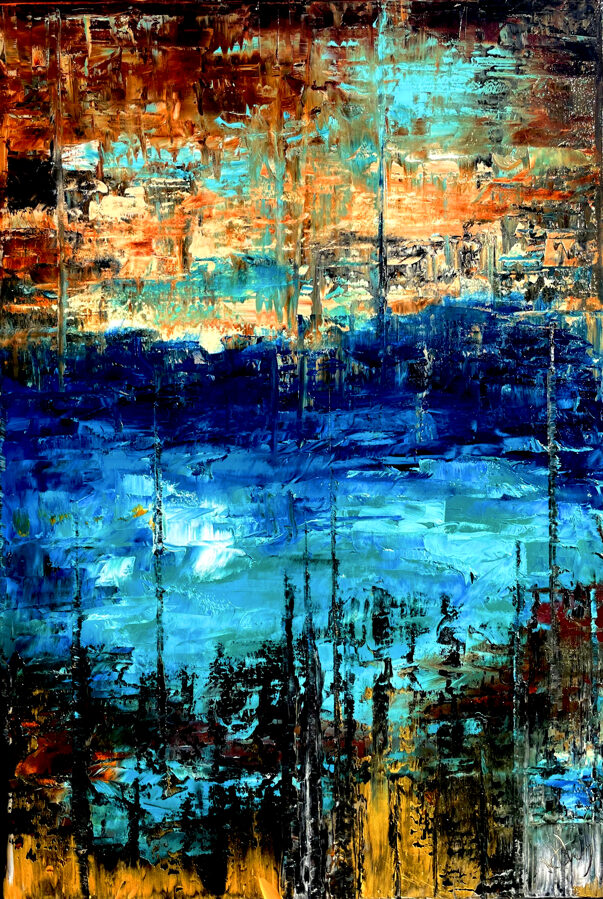
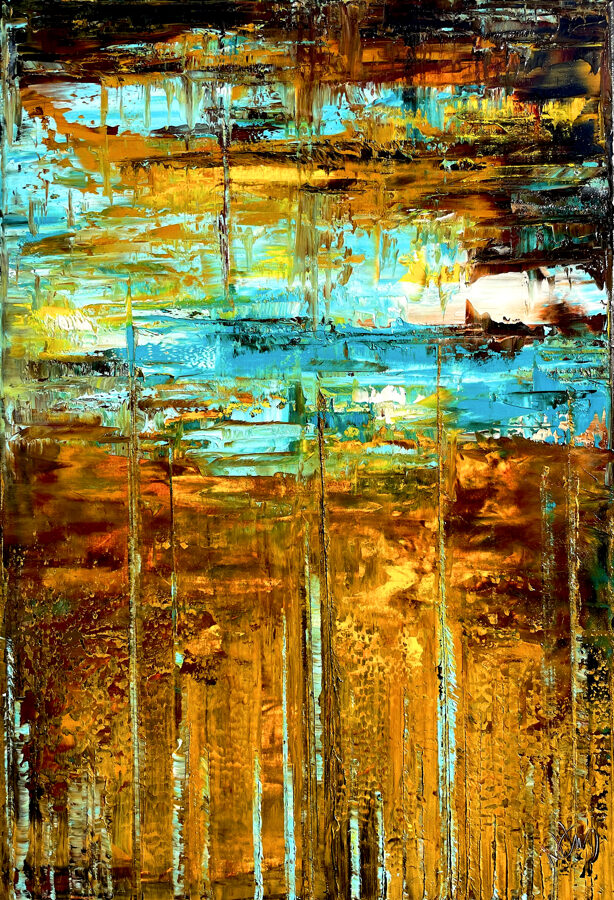
This abstraction displays the legend of Calypso and Odusseus with unparalleled geometrical exuberance through the alternation of increasing and decreasing energies. What makes the composition extremely unique is that this time the artist tells the tale through a series of standalone miniature paintings. The turbulence of blue colors on the left depicts the shipwrecked hero, thrown to land at Ogygia, saved by Calypso. The red stripes trapping the dark forms represent the beautiful nymph whose prison Odusseus was held captive for 7 years. Within the confines of the dark silver rectangle the red square stands for Calypso’s love offer, while the olive green patches drizzling gold particles show the promised immortality. The miniature created with white and blue on the right depicts a homesick Odusseus gazing into the distance. The square, decorated with golden colors, celebrates the fortunate homecoming of the hero. At the bottom of the painting there is a green stage divided by ups and downs, above it 3 skeins of gold thread levitate, their threads being led by the Moirai, the incarnations of destiny.
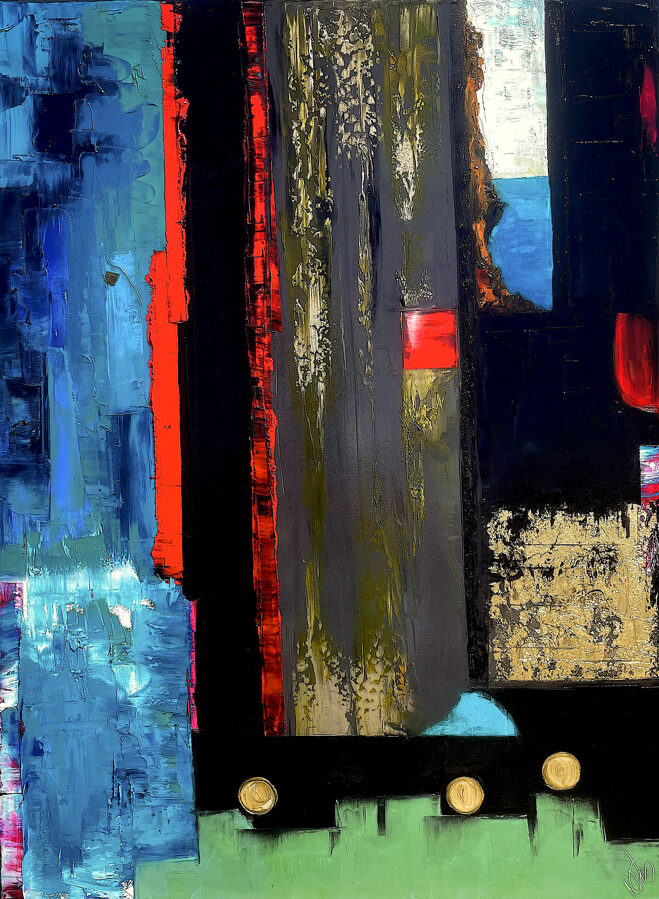
The color bars cutting through the painting vertically are a collection of myths revolving around the golden apple of Eris. The painter defines the attribute of the goddess of strife by emphasising the malevolent nature of the symbols.Therefore unrest can be discovered in the patch embodying the discorded golden apple, dismantling in the center, clinging to a red line. Yet the apple responsible for war and bloodshed still cannot spread restlessness in this testament of a soul trying to find justice. Tamas Naray, as a bard of Truth, highlights the optimistic horizon with his colorful piece of art by balancing his lines and patches and by emphasising Ananke, the golden circle that symbolises a Destiny that is always prone to equalize. What is most interesting about the painting is that the artist hid the legend of the Trojan War in the composition, amplifying the narrative joy of the forms.
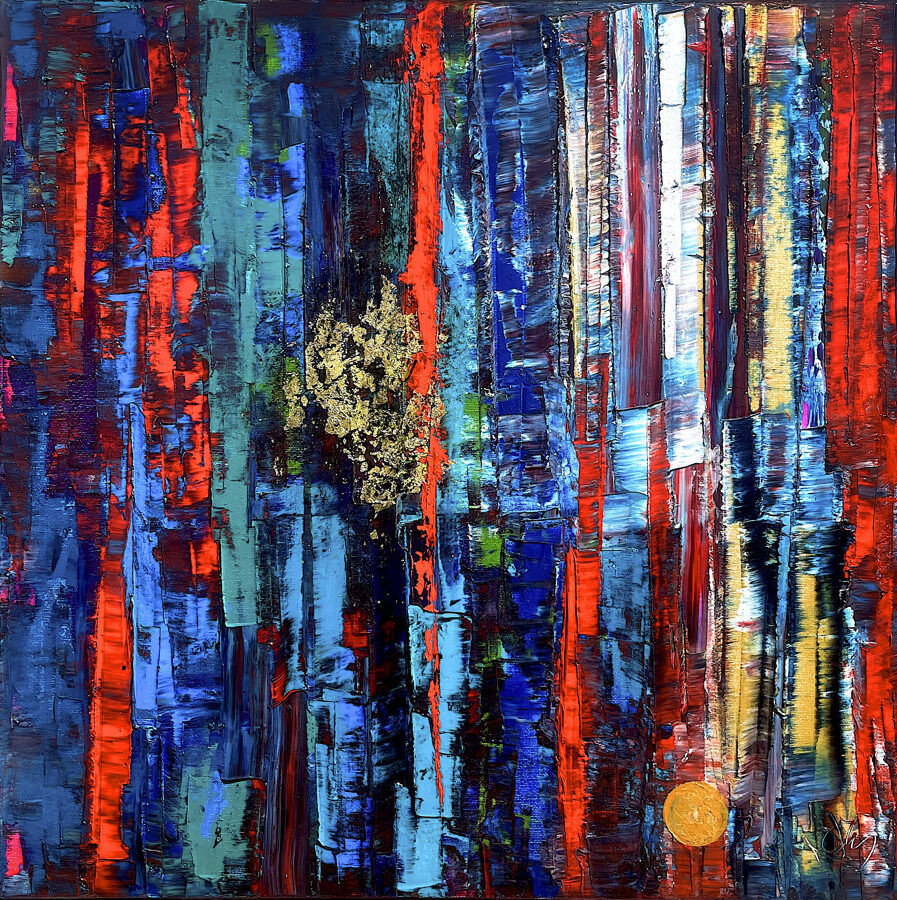
Constructed with wisdom liberated from the depths of the artistic instinct, the composition depicts a cosmic battlefield. The silver-blue gleaming base, visualized with a pearlescent spark, is captured with impressive confidence by the artist’s conscious brushstrokes, showing a symbolic struggle unfolded at a higher level of existence. In the sacral battle enduring the power of millennia, supernatural forces and human nature clash into each other. Heracles is in a battle with Antaios, who inherits the physical strength of his father, Poseidon, and is kept immortal by the magical energies of his ancestral mother, Gaia: he is being re-energized each time his feet touch upon the ground. Marked with a brilliant circle, Ananké embraces Heracles in a golden nebula, illuminating his mind and disconnecting his seemingly invincible opponent from the ground. Fate directs the stream of ivory whites in two directions, conducting the twisting and turning path of the more dominant lane back to the blood-soaked land where it reunites with Antaios's mother, Gaia.
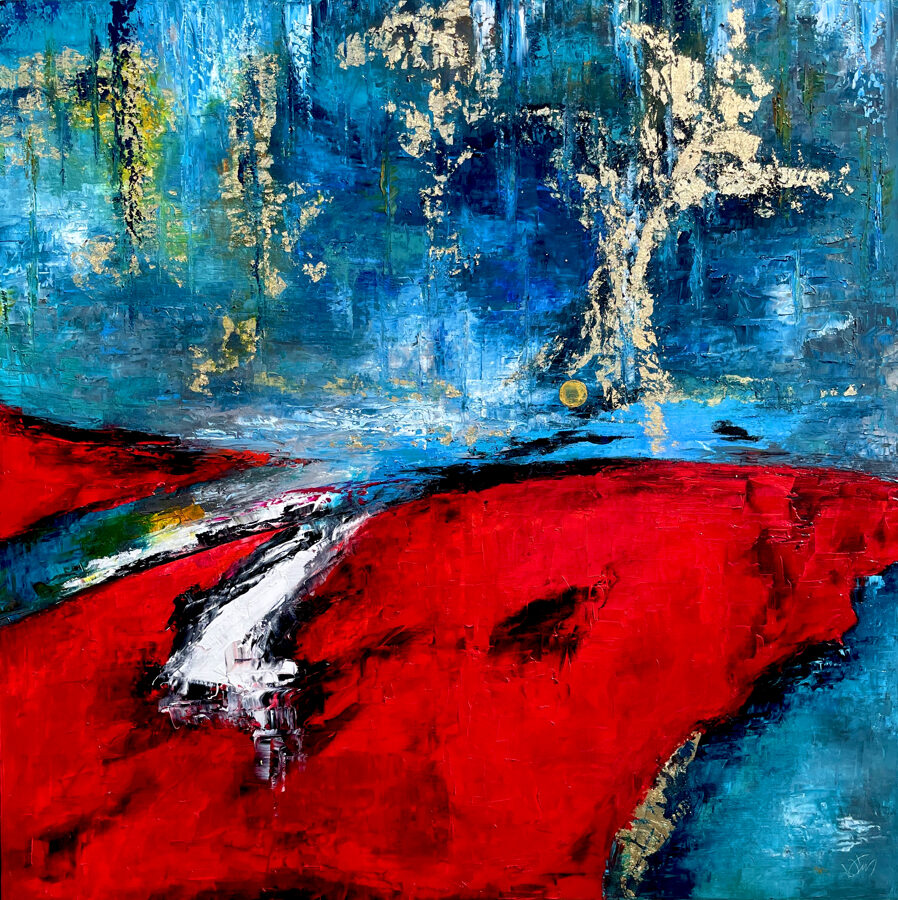
The painter’s vision, which creates an epic of congruent textures, depicts the legend of Adonis. According to the story, Persephone holds Adonis in the underworld - painted with red -, however Aphrodite also develops a desire for the young man. Adonis decides to spend half the year with the Goddess of Love on Olympus - painted with shades of blue. The sharp-eyed viewer can instantly discover that the lower and upper fields complete each other; everything rhymes with everything in the stable-structured painting. Presenting more than just the myth, the masterpiece, with the technique of highlighting, encompasses ‘mosaic’ paintings that can be interpreted as independent works, with which the painter interprets the nature of choice and decision. In the blue-framed miniature placed to the underworld part, a sundial can be seen that counts the finite time of our lives, the quality of which is influenced by our fateful decisions. The miniature shining in pink in the bluish sky is a portrait of Adonis looking into the mirror with great confidence regarding his decision.
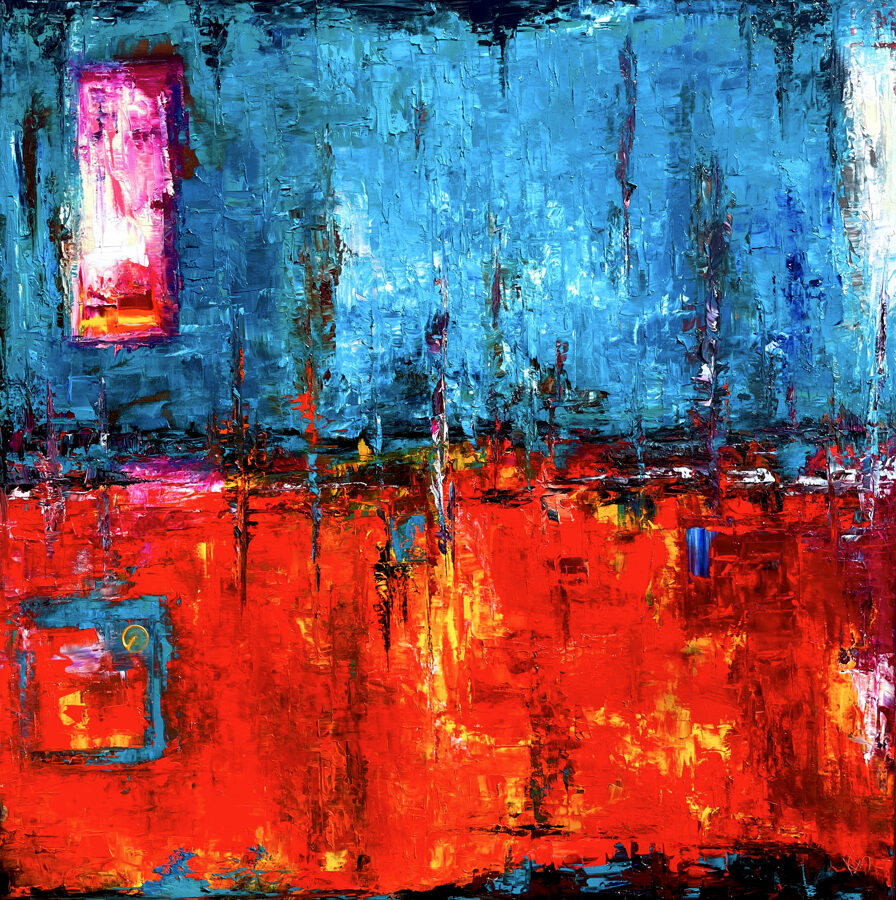
This poetic painting, shining with an unearthly flood of light, interprets the lyrical poem written by Sappho - the ancient Greek poetess - to Aphrodite. The upper texture, breathing in an unbreakable harmony, flooded with a pearlescent mist, is cut with black patches of aching amorous desires and the painful experience of hope. Discreet details and intimate nuances emerge in the lower field with collapsing colors glowing in red. The sighs adjusted to the heartbeats keep longing in playful dreams of a thousand colors. The fiery surface, sung with scorching passion, hides a strange miniature image. The golden circle embodied in the tight embrace of the black square symbolizes the fate of unrequited loves. The radiant spots in the frame resurface at the bottom of the abstraction, where the dreams of lovers come true with the power of sunlight.
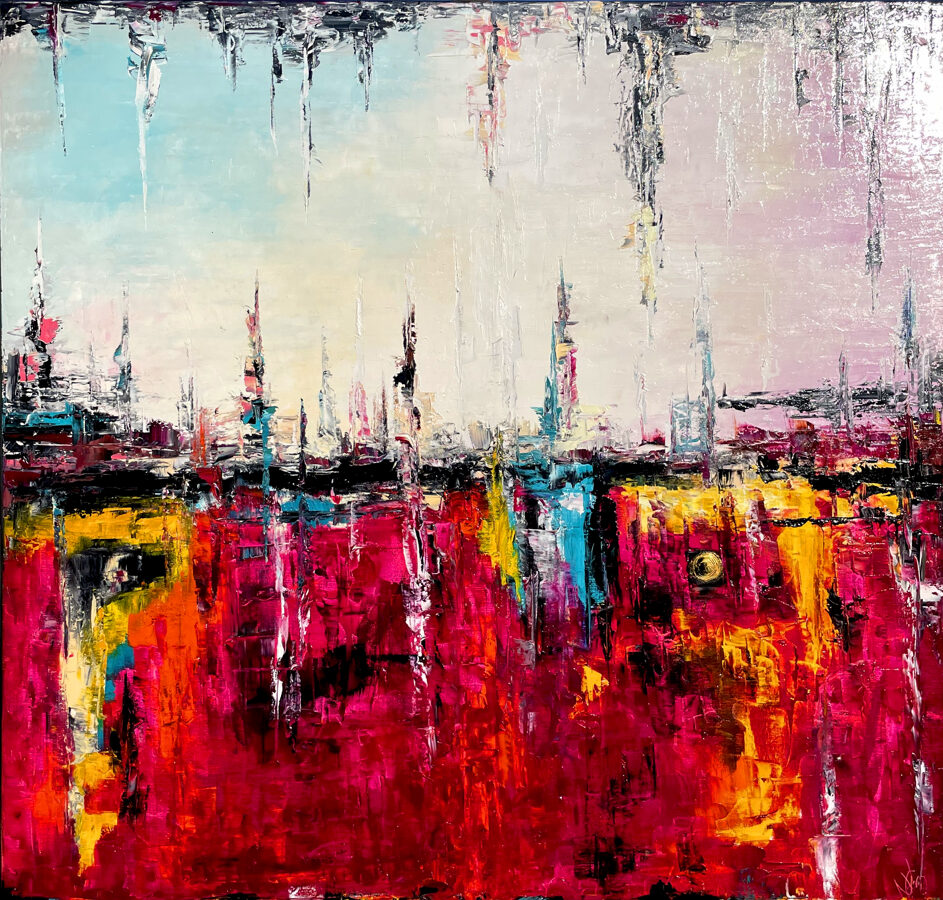
The frame, scorched by the unbridled fires of the eternal universe, interprets the passionate confession of Zeus’ everblazing love. The main motif of the scatteredly illuminated composition, enhanced with harmonious dark tones, is the rainbow-esque beam of light that splits the blood-red sky, making its way with the cathartic power of divine revelation. The king of the Gods of Olympus descends in the form of an eagle to take the Trojan prince, Ganymede, who sparked up his desire. However, Zeus cannot keep the prince with him. The work depicts the moment when Zeus raises Ganymede to the sky, from whom then the wonderful constellation of Aquarius is formed in the infinite darkness. The golden circle symbolizing Ananke gives its blessing with a magical turquoise whisk to the lovers who have found each other by an ancient instinct.
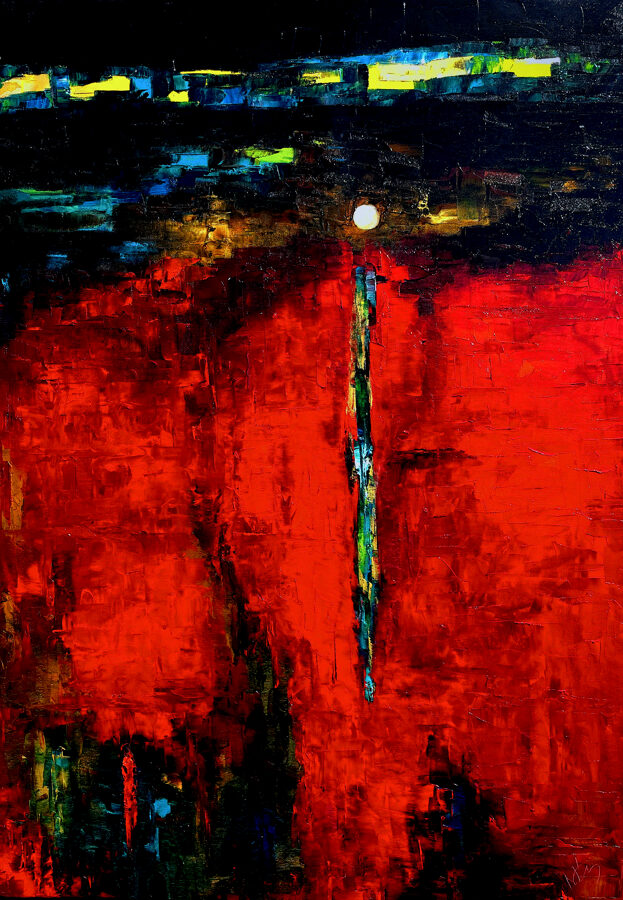
This artwork, crafted in the smallest detail, with the most complete devotion of artistic attention, fills with meaning the bluish-green colors streaming in a blood-red glow, and the recurring circle motif that symbolises Ananke: fate. A bouquet of olive branches descends from a bright streak that keeps the top of the frame in equilibrium; a bouquet which was a gift from the goddess Pallas Athena to an Attican polis for gaining its patronage in a competition with Poseidon. The ‘olive branch’ symbol’s life-giving and nourishing blessing interweaves the abstraction’s texture, that was conceived in fertility, with its blue-green roots, calling Ananke - that shines as the core of life - for works of creation.
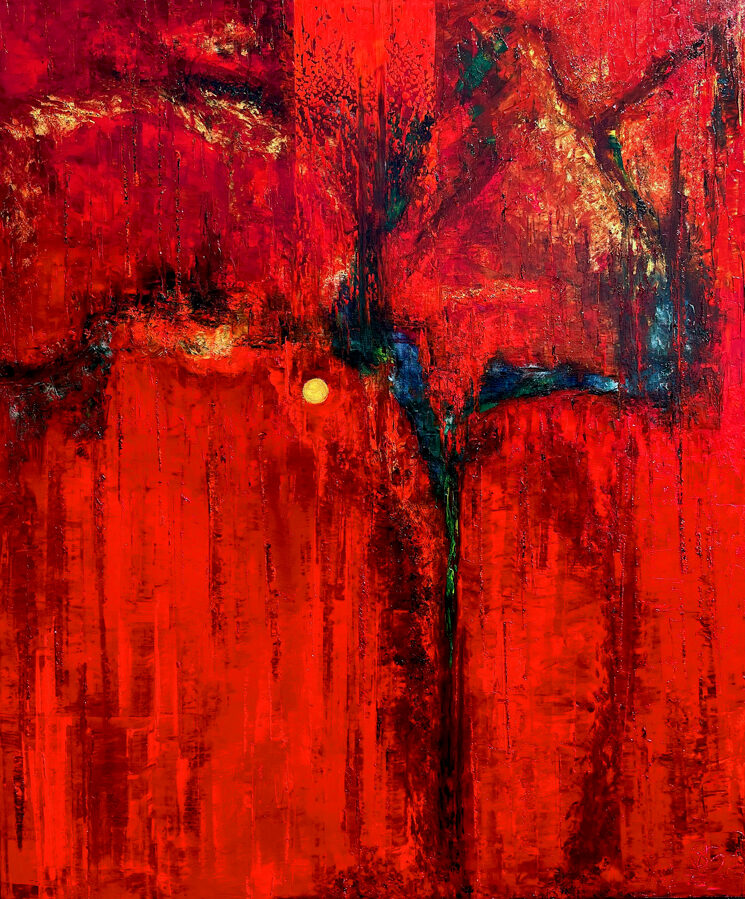
On the red-soaked canvas, typical to the artist, exact figures tell the legend of Perseus, sometimes with subtle, other times with hasty tones. The massive object looming in the center is Danae’s bronze chamber prison, open to the sky, where her father locked her up in fear of the Delphi prophecy that predicted his death by his own grandson. The golden circle that symbolizes Ananke, however, fulfills the prophecy, and Danae, despite the forbiddance, conceives from Zeus, who descends in the form of a shower of gold. The pure white square that symbolizes the soon to be born life is illuminated by the sun-yellow motif with gentle love and crowns the fate of the infant Perseus with a protective halo. Energized by deep colors, the longitudinal burgundy rectangle is the motif of chosen heroes. On the left side of the frame is the scene of the escape of Danae and her son from being casted into the sea. The collection of expressive mosaics on the right side of the abstraction recounts the adventures of Perseus: the defeat of the Gorgon, and the liberation of Andromeda.
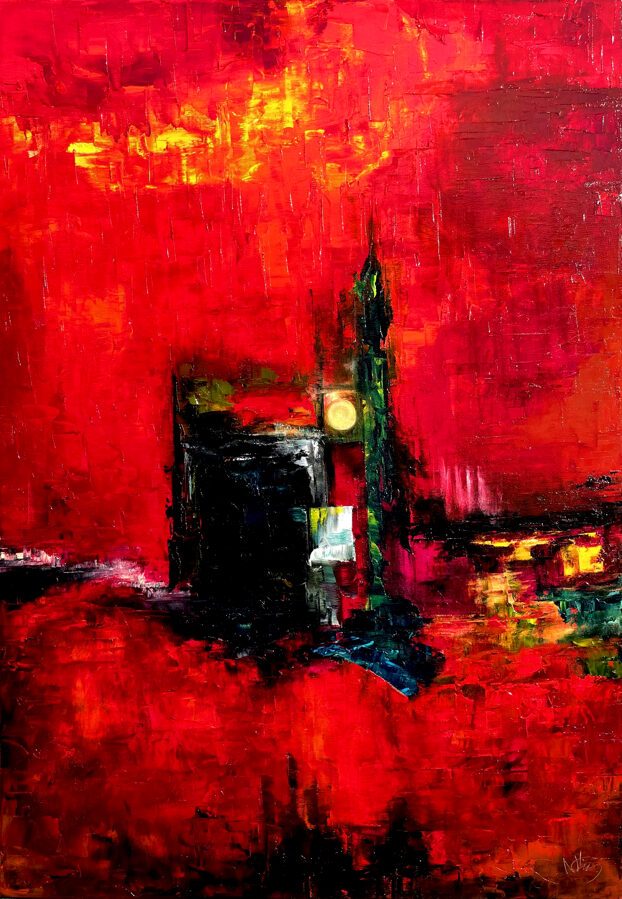
The dazzling colors of this artwork, defined with exceptional formulative means, depicts a scene of a peculiar union conceived in ancient passion. Bathing in a sea of turquoise crystals covered with a lyrical veil, the beautiful body of Leda encourages the swan-shaped Zeus for seduction as golden lights shine playfully on her. The waves of desire, intertwined by a dance of fine strokes, bring fulfillment in a red glow, with pearlescent bird feathers softly crumbling away, as they harbor the promise of a new life, like gracefully opening shells. From the feathers taking off, four of them get separated from the flock and glide down gently to embrace the fiery, pulsating vertigo that is Leda’s fertile womb.
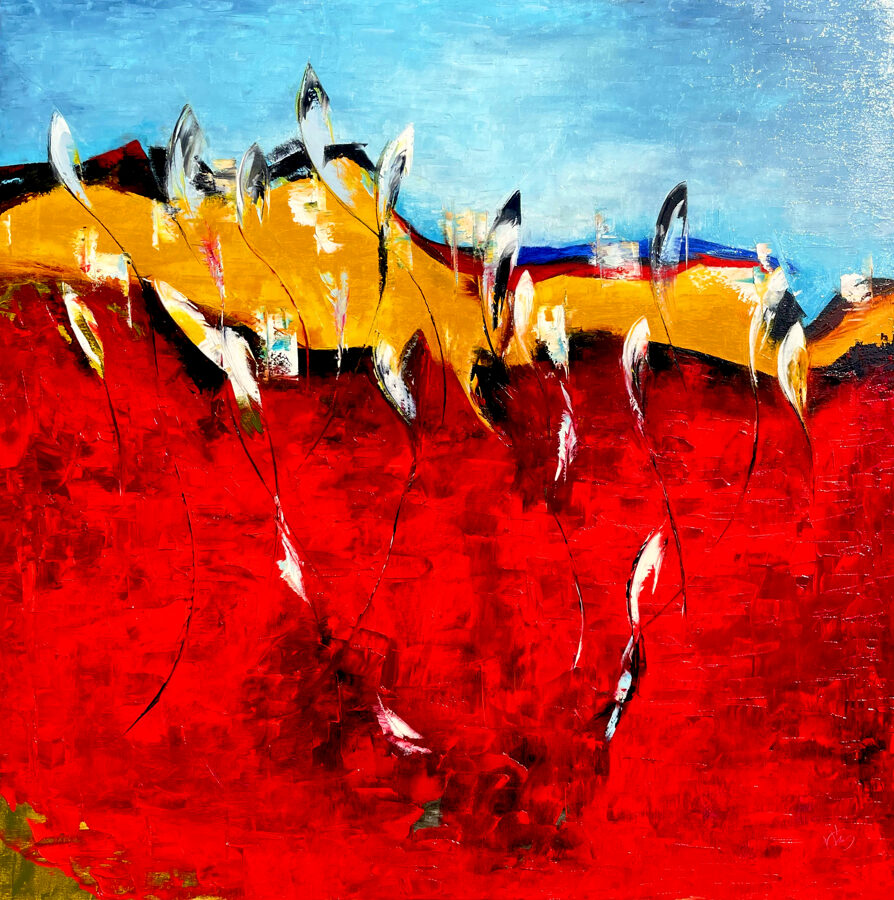
Known as the father of geometry, the Hellenistic mathematician is the author of a series of theoretical achievements. ‘The Legacy of Euclid’ painting is one of those works of Tamás Náray that serves as an example of his precisely designed expressive power. The abstraction is a visual manifestation of Euclid's theorems, highlighting the scholar's revolutionary ideas with the help of mosaic images: in addition to intersection, congruence and tangential, certain metric properties can also be discovered on the frame. The artist derives the spatial editing tasks on the canvas back to planar tasks, and examines the divided geometric elements and their nature, both individually and as a system. The composition constructed in a diagonal arrangement is characterized by stability and mathematical equilibrium as regards to its proportions.
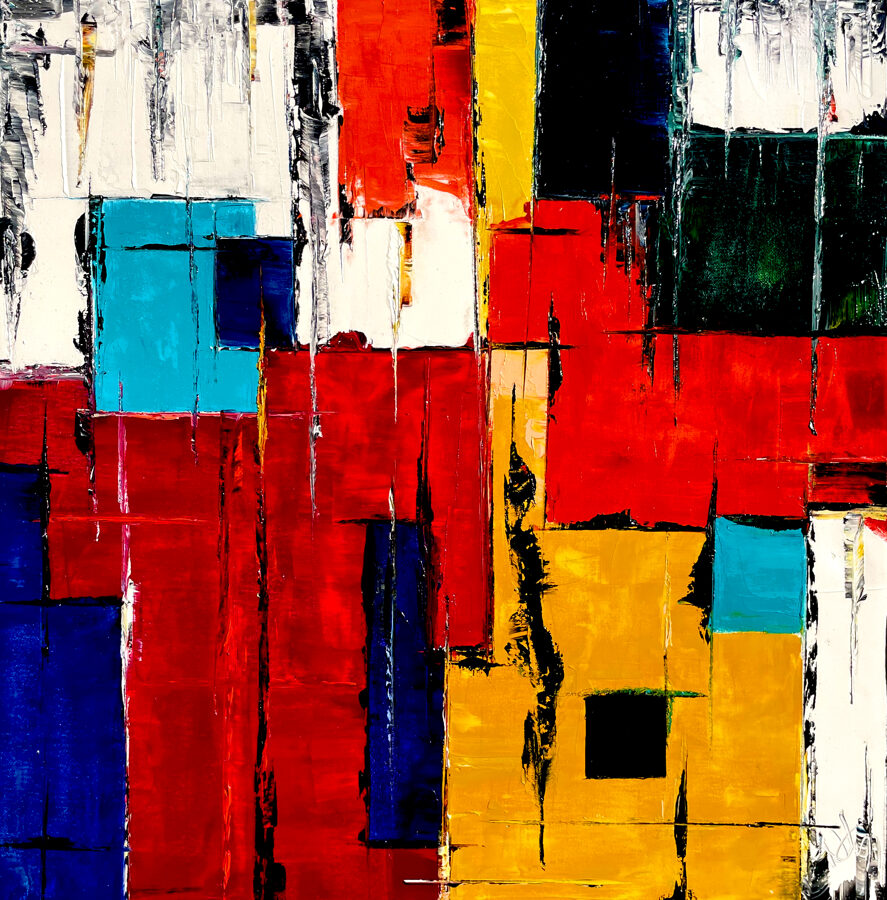
Despite the busy scenery of the myth that comes to life in this abstraction, the filling of the almost schematic surfaces is modest. The plot lies in the corresponding dynamics of the forms, with the main emphasis having been laid on the coloring. The ivory white texture, enriched with ocher tones, is the realm of the God of the sky; the tragedy of Uranus is marked with a red dawn decorating the heavens, accompanied by black shadows. The dark tones descending from the sky fill with anger and clash with a dramatic force, marking the line of the horizon. The god - fearing to lose his power - locked his children in the depths of the earth, but his wife, Gaia, made their remaining free son - Kronos - rebell, resulting in the castration of his father. The consequence of this barbaric vengeance is that, from the blood-soaked sea, the goddesses of revenge come to life. Beyond the raw poetic reality of its outspoken details, the artwork also depicts the fallible and mortal nature of the gods.
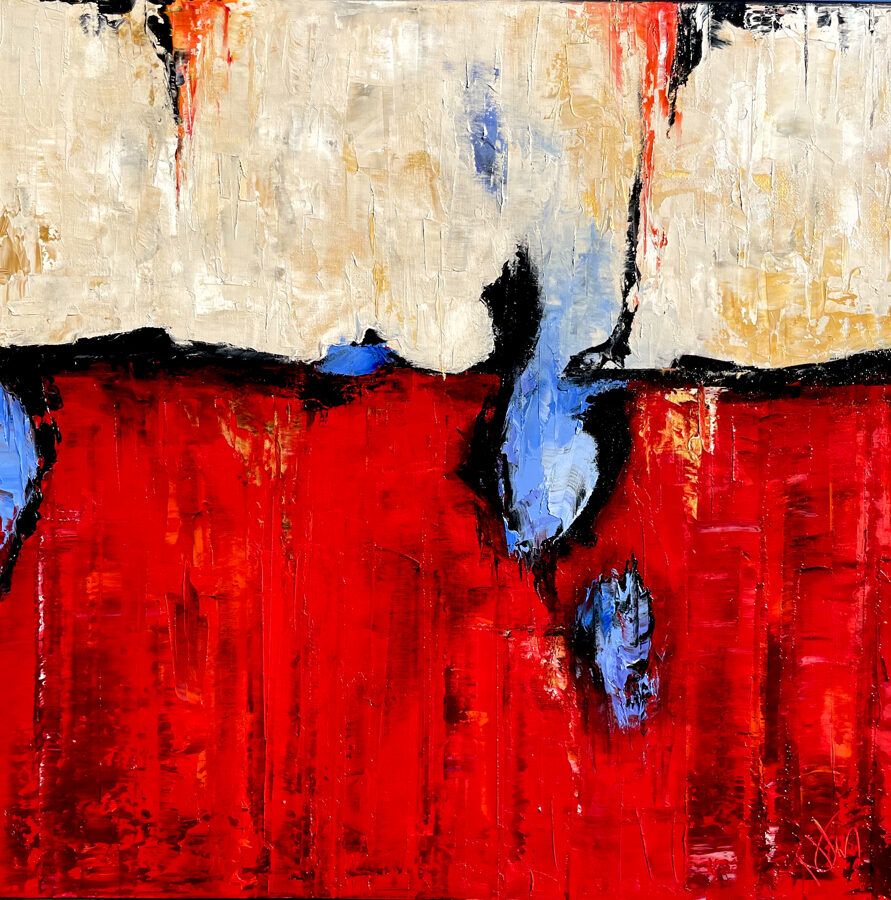
This painting, depicting a cathartic event and being divided into irregular parts, is characterized by the summary of dynamic movements of the large surfaces and the poetry of the smaller nuances hidden in the details. The hard strokes that symbolize the wrath of Zeus carve world-shattering black trenches into the frame. The inhabitants of Arcadia, who have committed the sin of human sacrifice, are punished with a mantle of fire, their lands with a devastating flood by the king of gods. The golden circle of justice, the Ananke, which also has power over the gods, rearranges the order of the created world in time and space. The privilege of Regenesis is the reward of surviving Deucalion and Pyrrha whose figures appear in a black, linear representation in the middle of the frame: and in a sin-cleansed Arcadia, painted with chalk white, the chosen people breathes new life into existence with a sacred rite. Throwing stones behind themselves that represent the bones of Mother Earth Gaia, human figures emerge to spread roots in beige patches in the flood-stricken, virgin land. The construction of god-will that dominates the center weakens and falls apart. The abundance that follows the rebirth of the blood-soaked surface is provided by the gold and blue patches on the right with lifegiving water fountains and the blessing of fertility.
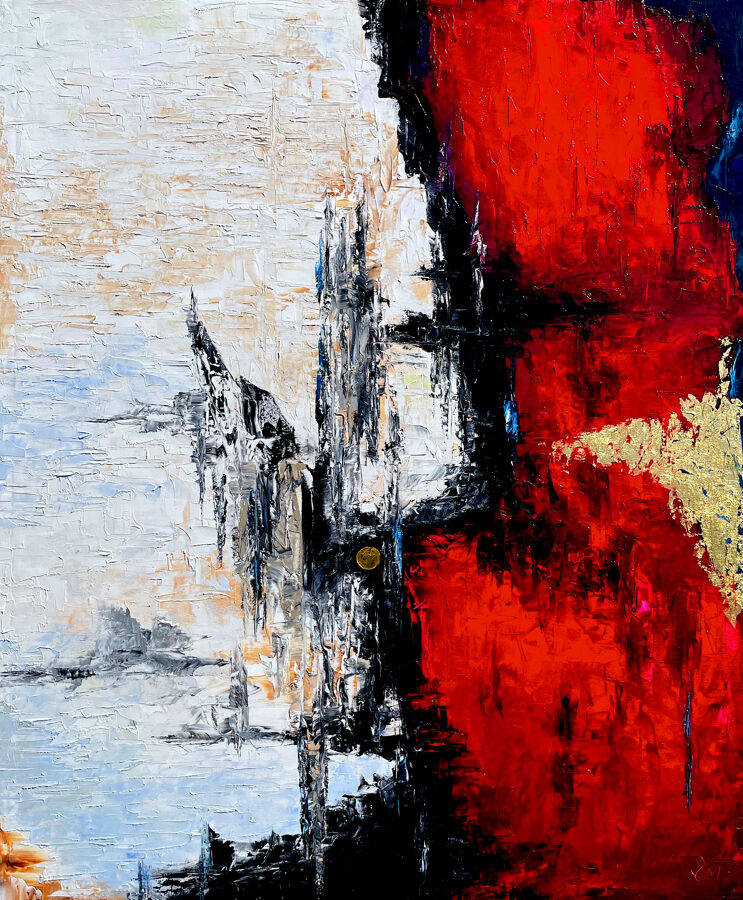
The compositional balance of the painting divided into two showcases the all-decisive role of the goddess of destiny, Ananke. The texture of the upper portion sparkling in golden shine symbolizes the future, on its right field a shining circular form serves as a motif for the inevitable knowing of our lives and the spindle that weaves their thread. The overarching red, yellow, and ivory color stripes separating the above and the below show how the nature of the archaic worldview is divided to different stages. The supernatural spindle that rules over the axis of the world connects everything in existence with its magical thread and materializes the future. The blueish-silver waves sprinkled with pearlescence crystals at the bottom of the abstraction gently rock the course of our lives, of which turns are being intertwined by Anake’s spindle and sentience.
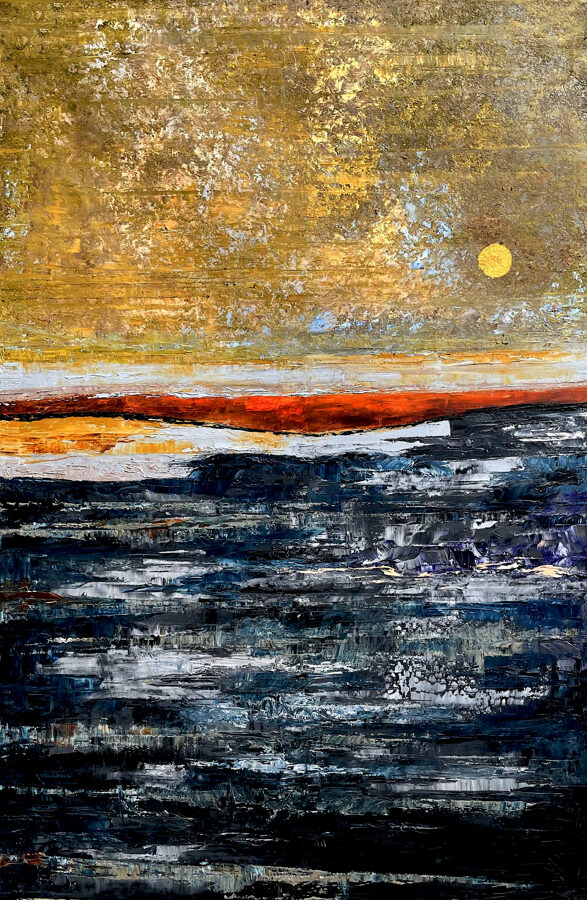
This cathartic artwork, enhanced with telling forms and symbolic colors, is the imaginative means of the painter to clash together the nature of Greeks striving for perfection and Romans applying brute force. The finely detailed surface of the brilliant blue mass represents the declining Hellenistic kingdom, while the territorial will of the red texture symbolizes the plundering Roman Empire. In the center of the frame the irregular shape of gold elements depict the ransacked home of the gods: the crushed pieces of Mount Olympus and the shards of the crystal palace reflect the image of the abducted Greek gods. The cult of the stolen and renamed gods strives in Rome, while the legacy of their timeless myth is kept alive in Greek memory.
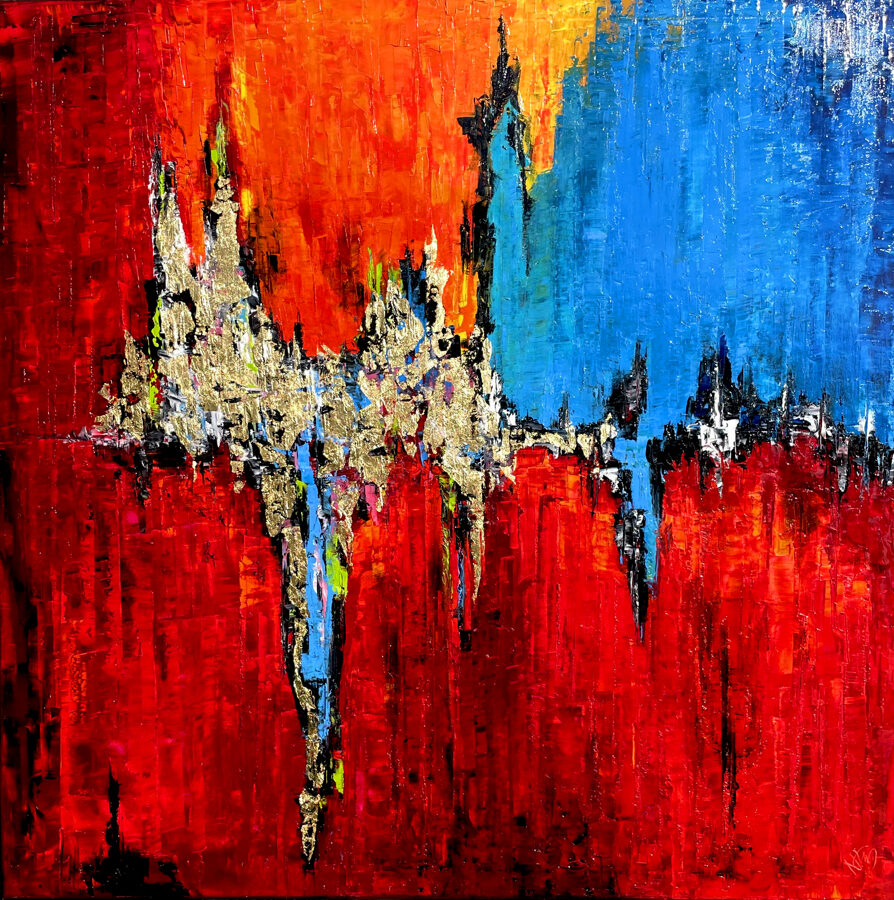
The slightly strict, geometrically ordered display reveals itself with a soft, lyrical timbre in a harmony of light blue, turquoise and pearlescent tones. The powerful eruption in the center of the image is not unlike a special diagram of time. We are in Hyperborea, where eternal spring reigns, and what is the favorite residence of the god of prophecies. Knowing the destined order of the months, from autumn to the equinox of spring, to distance himself from the dark energies, he travels to the mystical island beyond the North in his swan-drawn chariot. Apollo, praying for the sun, empowered by the light, is being energized in the winter shelter surrounded by a veil of silence. Emerging from the cold background, the brownish, greenish-blue, black, and red colors of Hyperborea intertwine with an unbreakable tranquility through an infinite perspective. The upward and downward directed strokes of the floating form, nourished by the abundance of eternal spring, stretch carefreely into eternity.
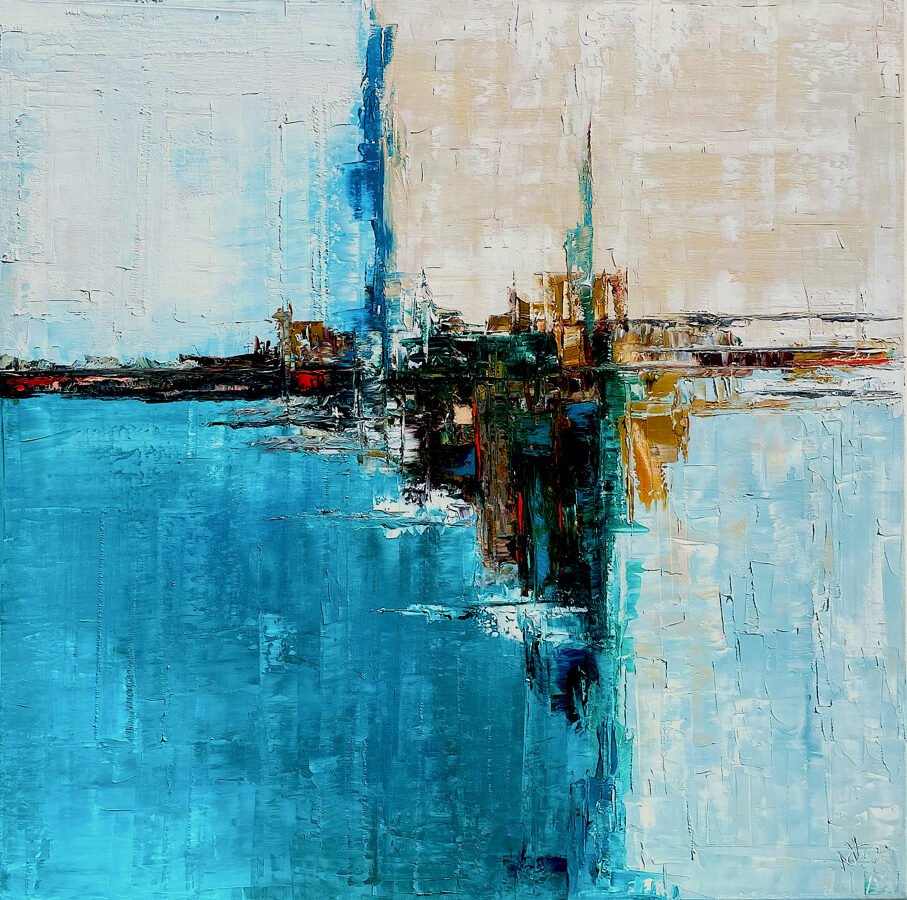
The wisdom of the painter, by presenting deep love with a lyrical tone and by beautifully defining a mythical atmosphere, charms us with unparalleled visual power into the depths of the immeasurable seas where Triton, the mermaid god, lives. As the son of Poseidon and Amphitrite - half man, half fish - he dominates the power of the infinite waters by blowing into his mussel horn to animate or restrain the winds that control the waves. The full-bodied dark forms of the aquatic world shining in greenish-blue form a gateway to the otherworld with their hills and slopes. The vividly breathing surface that transforms into pinkish spots constitutes soaring bubble clouds. Arriving from afar to the realm of Triton, the tired wanderer is levitated and bathed in twilight dew with beautifully shaped pastel spots enchanted with mermaid dreams.
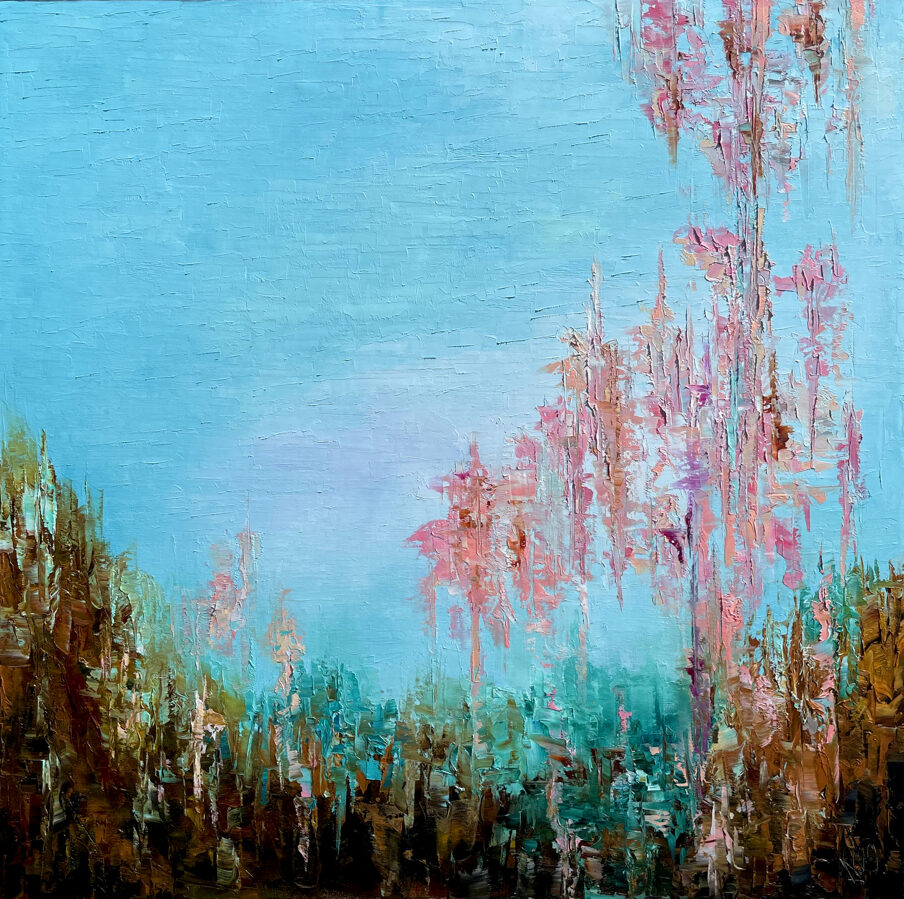
With the confession of the profoundly silent forms in the veiled light, the artist seeks to understand the higher purpose of existence by researching the secrets of millennia. The abstraction, composed by the love towards nature’s beauty, depicts the deserted beach of Hellas. The protrusion of the ivory rock, painted with the intent to display shortening distances, decorated with golden trenches, divides the immeasurable waters to low and high. On the shore, a tree-like mass facing the sea emerges from the plane of the canvas; the form representing the passing time showcases the artifact of Minos in its fading light. The disintegrating pieces of its fragmented body are subtly picked up by the soft-flowing lower waters, and the brown parts disappearing with the blue-silver waves continue to shine in pearlescent patch reflections on the dark blue texture of the upper waters. The airy surface of the celestial mantle, which wisely rests onto the infinite waters, symbolizes the vigorous truth of Greek culture for posterity.
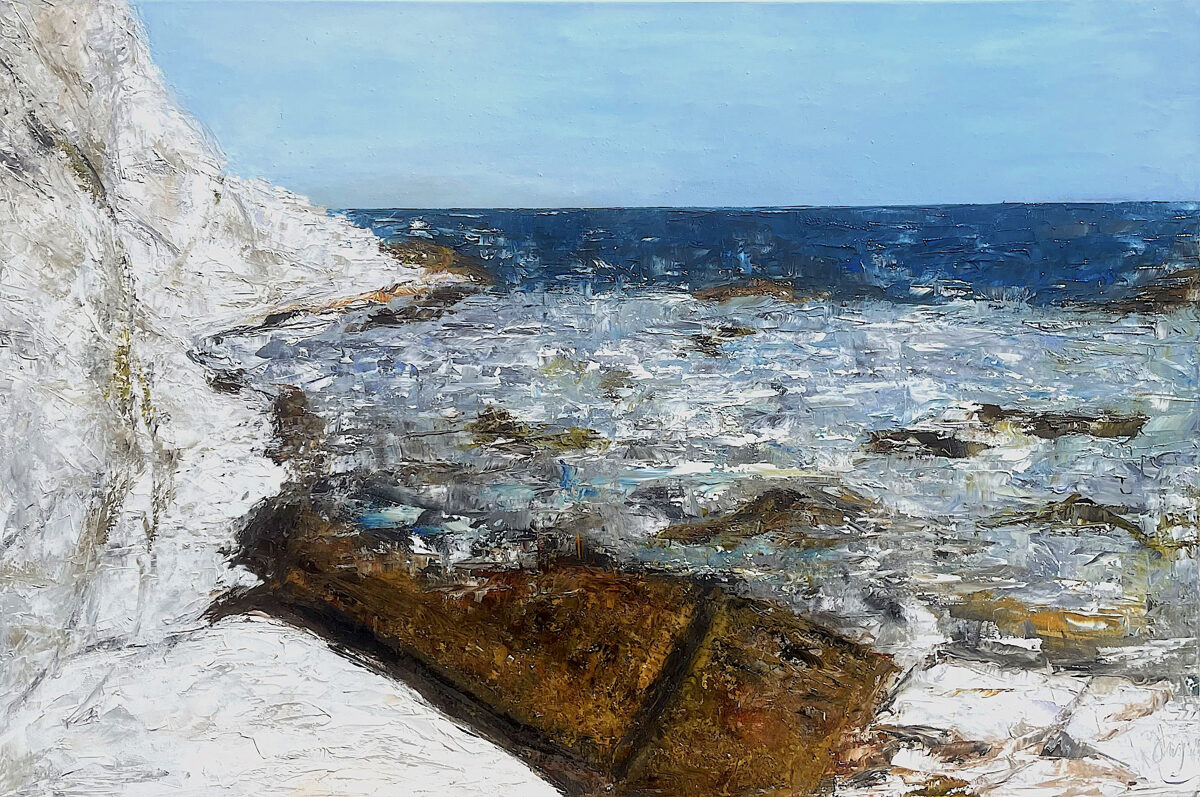
The Land of Nymphs is a blend of classic discipline and romantic fantasy. The crystal-colored horizon, floating through the endless sky visualized by traditional means of landscape painting, and the undisturbedly sparkling water-surface beneath together form the intertwined shape of a floral wreath that symbolically projects the miracle of creation in front of us. The nourishing forces of the immeasurable depths emerge from the bottom of the frame and bring life with an oil-green dew to the hiding place of the nymphs. The fairies of the mountains, valleys, forests and ridges are the muses of beauty and fertility as companions of gods and lovers of heroes. The composition held in a weightless levitation - with its texture resembling opaque gems - is forged into a fairytale vision by ornaments disintegrating into a thousand coloresque petals.
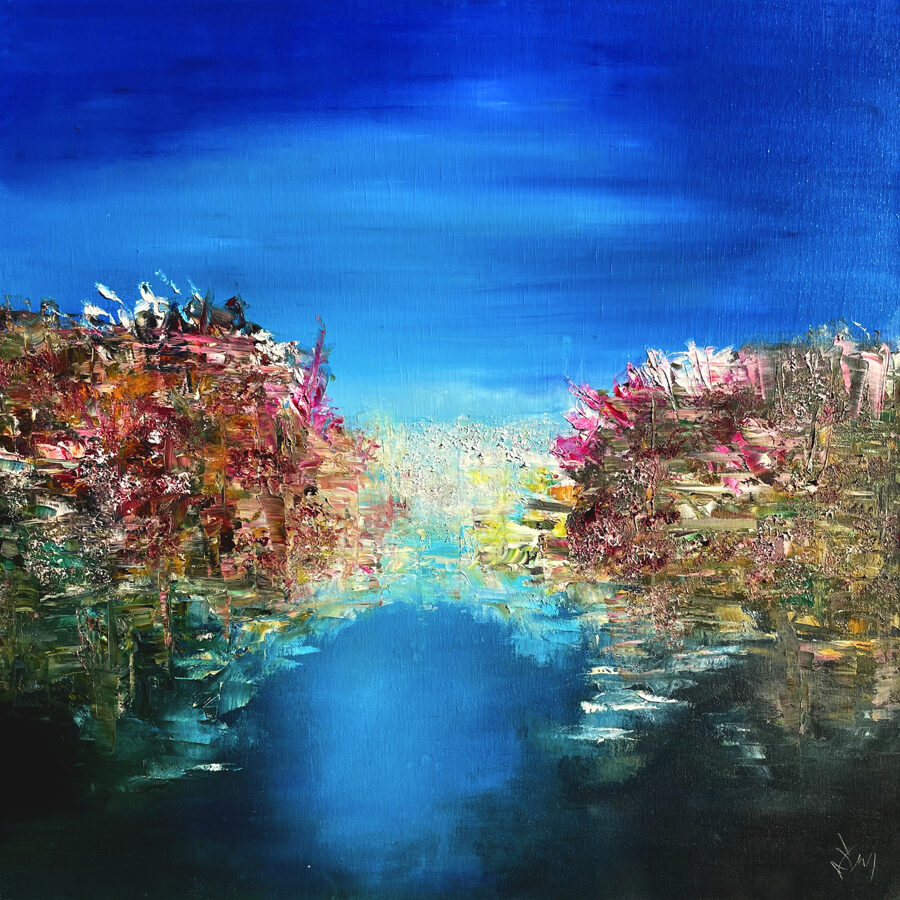
The structurally well-integrated, carefully crafted composition depicts the steps of the Acropolis, towering on blue-grey limestone, standing out from the plane of ordinary existence with sacral empowerment. The meticulously elaborated brownish-toned angular components, leading to the shrines of the construct that symbolizes the proximity of divine holiness, are the elements connecting the spiritual states of consciousness ‘above and below’. The divinely connected journey on the ascending steps is a transcendental, initiative ritual. The imaginarium of an exceptionally creative declaration paints the faces and attributes of the inhabitants of Olympus with colorsque motifs hidden with witty taste. Observing the richly decorated texture of the frame, one can discover the sword of Ares, the olive branch of Athena, the bow of Artemis, the scepter of Zeus, the peacock feather of Hera, and the caduceus of Hermes.
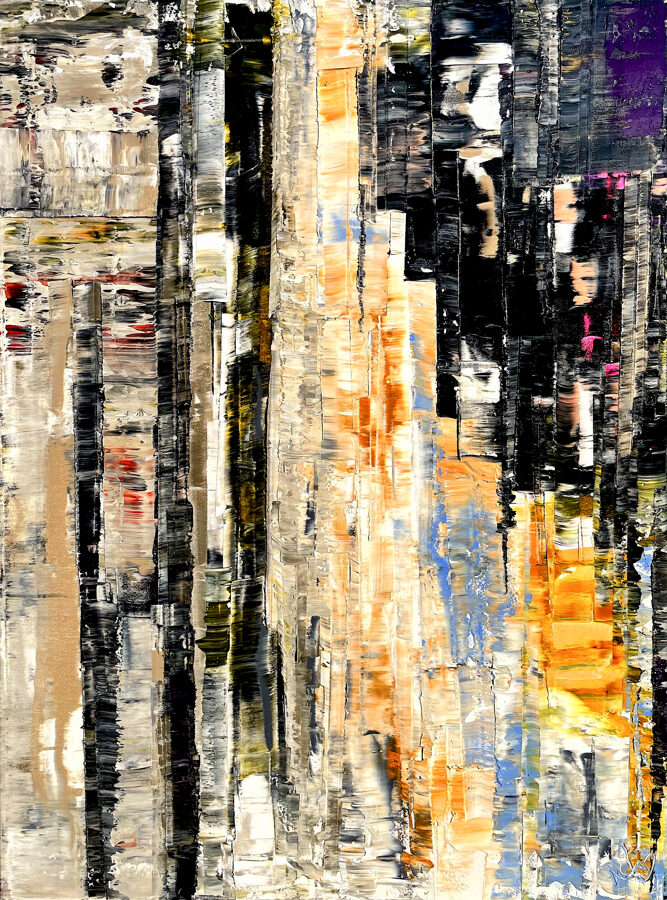
The painter, speaking the language of diversified masses, flexible shapes and adaptive fields, tells us about the Periclesian era, the golden age of ancient Hellas, by placing symbols and by bringing the mythological legendarium to life. The glowing pearlescent turquoise-colored shape on the left side of the frame depicts Athens, and with its homogeneous surface resembling water, like a proudly stretched sail, references the maritime monopoly of the dominant city-state. The bustling rectangle on the right, enriched with dark tones, puts the other Greek polises into a framework, in which the firmly emerging branching column of light symbolizes Sparta, the eternal rival. The golden shape wedged between the two heavy masses symbolizes the Periclesian politics of equilibrium, which entrusted Athens - leader of the Delian League - with the main role of power. The golden texture of the canvas shows the glorious present of Hellas in its heyday, its future doom however is forecasted by the master with deep, dark cracks. The most peculiar part of the work is the small, circular shape that symbolizes Ananke, the inevitable Fate that rules also over the gods of Greek mythology.
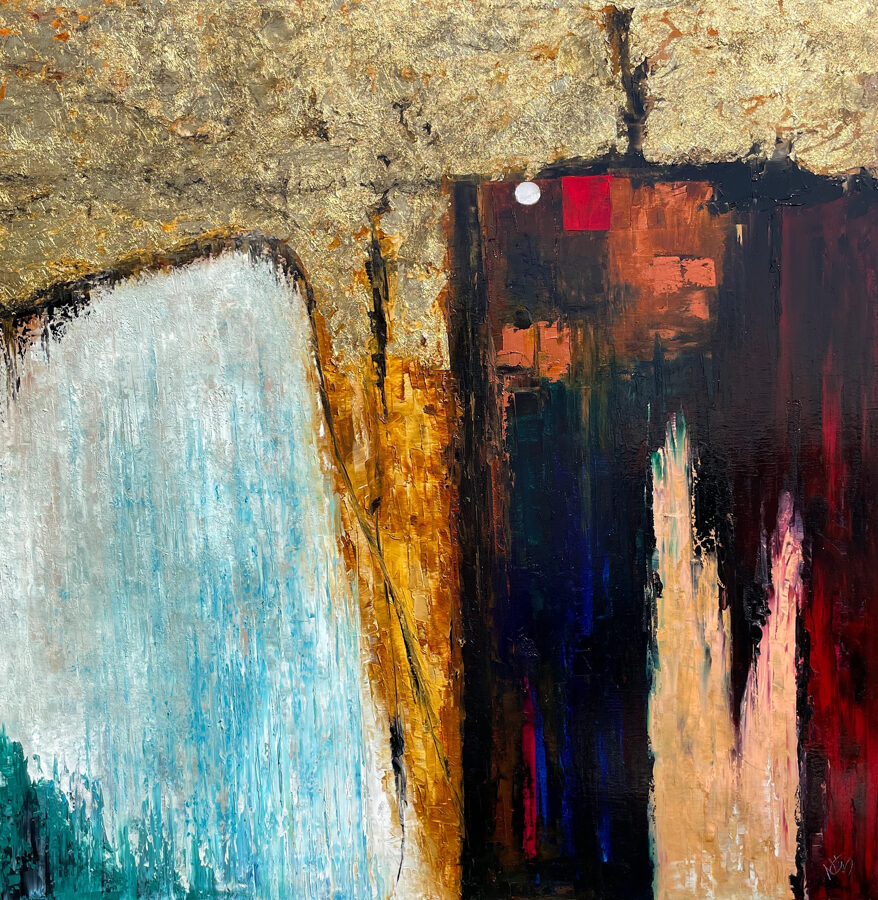
Cart is empty.